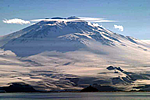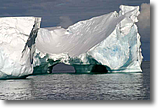CORSACS Comes to a Close

Terra Nova Bay is the site of two national bases, the major one being manned by Italy (Baia Terra Nova). It is occupied seasonally, and a site for jump-offs into the continent's interior. It is helped greatly by its closeness to McMurdo and depends to some degree on US logistics. It is the site of the deepest spot on the continental shelf, and during winter has very high katabatic winds. These density-driven winds flow off the glacier and over the ocean, and make the bay a site of intensive ice and deep-water production. However, this year we have seen absolutely no evidence of high winds here (see pictures). Indeed, the weather has been spectacular, allowing the science party to enjoy the beauty and grandeur of Victoria Land. In the northern portion of the area is ,2733 meter (8,966 foot) Mt. Melbourne, the only active volcano on the mainland of Antarctica.
Ice continues to plague McMurdo Station. The Russian icebreaker Krasnin was hired by the
National Science Foundation to break the ice channel into the station, but under heavy ice conditions it sheared
one of its three propellers; as a result, it cannot break ice efficiently. In addition, the channel that it has
broken is being compacted laterally, and so the channel remains difficult to pass through. The fuel re-supply tanker
is at the ice edge, but due to the conditions of the last 12 miles of the channel, cannot get to the pier in McMurdo.
The re-supply ship American Tern is also due to McMurdo in four days, but it remains uncertain if it can reach
the pier either. The Palmer, being an ice-breaker, should be able to get to the pier, although it may take
much longer than originally intended. We are scheduled to arrive on January 26. Because the Krasnin has
another contract and must leave February 2, NSF has asked the Coast Guard to send the Polar Star to McMurdo to
assist if needed. Their transit from Seattle is expected to take 30 days, so it remains to be seen how helpful it will be.
The major problem with these delays is that fuel and food must get to the South Pole Station before air flights cease in early February. Right now they are likely going to keep the Pole's season open longer to allow more and later flights for re-supply. As of this moment the Palmer's schedule remains unchanged, and we expect to depart from McMurdo on January 30 to complete the final portion of IVARS.

